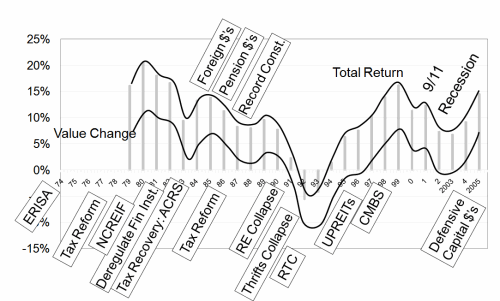|
QuestionTopic. How did we get here? A number of observers suggest that we are in unchartered territory for the commercial real estate market. Is the situation we face in mid-2009 really unique? How did we get here?
DrD's Answer
First of all, the real estate and related industries seems to continue to suffer from long-term memory loss. Part of that may be attributed to the relatively young age --in real estate years-- of many of the new players who were attracted to the industry during the almost decade-long bull run that started in the mid-to-latter 90s after the last collapse. In order to understand the impending crisis facing the commercial real estate industry is useful to take a historical look in to see if we can extract the lessons learned from the past. Before exploring the factors that led up to the current crisis, I should note that things are not as unique as they might appear. Consider the following.

To start, we should turn the clock back to when the seeds for institutional real estate investment were planted with the passage of
ERISA in 1974. The most significant impact of the legislation was to raise the prudent man criterion to prudent expert criterion. Under the
prudent man criterion, institutional investors to avoid real estate as a risk management tool based on its inherent complexity. However, under the prudent expert criterion, if real estate was an asset class,
institutional investors and
asset allocators were required to commit resources to achieve diversification. By 1978, institutional capital flows to real estate were still limited, due in large part to the absence of the return is series of asset allocators could use to understand how real estate with other
asset classes. To address that need the real estate units of the major life insurance companies including Prudential, Aetna, Cigna and Equitable created the National Council of Real Estate Investment Fiduciaries
(NCREIF). The objective of NCREIF was to create a time series for real estate returns that asset allocators could use along with stocks, bonds and other asset classes in making asset allocation decisions. In 1981, financial institutions were deregulated and allowed to create development subsidiaries.
In 1982 the Economic Tax Recovery Act (ERTA) creating
double-declining depreciation was passed. This attracted more capital for
syndicators, who doubled up with foreign investors and pension funds to create a surge of capital to real estate. This created a disconnect between the
spatial and
capital markets. This led to overbuilding which ultimately led to the collapse of latter 80s. Other than disposing of troubled assets, the real estate market shut down. When the commercial real estate market collapsed, the
RTC was created to work off that debt financial institutions. In 1994 faced with the prospect of filing bankruptcy, Taubman decided to file an
IPO and convert to a REIT and was quickly joined by a spate of other owner/developers including Simon, DeBartolo, General Growth and a number of smaller players. Around the same time, while the RTC was wrapping up its business, Wall Street investment banks and others sought to convert the temporary securitization of commercial real estate to an ongoing activity. During the mid-to latter 90s
REITs grew from under a $10 billion industry to over $200 billion, while
CMBS volume rose from nothing to a similar market cap.
Our success in recapitalizing the real estate market was quickly adopted across the globe, setting the stage for the worldwide collapse of credit and real estate markets that is now occurring. In 2001, the 9/11 tragedy attracted investors to real assets such as real estate which were seen as defensive investments. Benefiting from an improving economy and the government's support of homeownership for all and complete trust in self-control by financial institutions, the housing market went on a bull run characterized by easy credit. Thus, both the commercial and residential markets became disconnected from the fundamentals (i.e.,
Wall Street vs.
Main Street or Capital Markets vs. Spatial Markets). This disconnect led to the recent collapse since easy created permeated all asset classes and became an accepted mode of operation. Unfortunately, the impending problems in the commercial market have yet to be recognized due in part to attention being focused on the residential market and the broader credit markets. The disconnect that occurred on the commercial side that has yet to receive attention suggests hard times ahead as 2009 unwinds and the first wave of "distressed asset" sales hit the streets and the surge in bullet loan refinancing starts to build up going into 2010. Unfortunately, the federal government has few options to resolve the challenges the industry will face and the conventional sources of mortgage financing --including CMBS which is all but shut down-- will not be able to carry the ball without some form of intervention or innovation. What forms that may take remains to be seen.
|
Disclaimer and Copyright
The answers to questions I address on this website are my personal responses and may or may not accurately reflect best practices or current industry standards. Furthermore, they are not rendered as consulting recommendations and should not be relied on in making business decisions. I am offering them here for informational purposes only and hope to stimulate creative, objective, disciplined thought on the selected questions or issues. I reserve the right to edit my responses, add or delete questions, or restrict access. In answering questions, I am drawing on my combined academic and professional career and present them in hopes of improving the quality of decisions that affect the built environment and advance the state of the art and body of knowledge. If you have questions or suggestions for enhancements or improvements to this feature, please Contact Me directly. If you are responding about a question, please indicate the ID# to the lower right of the answer. |
|
